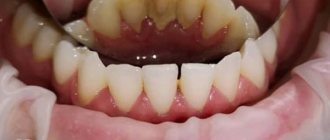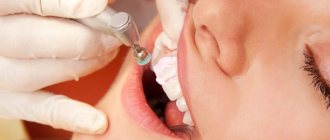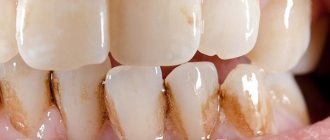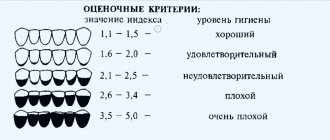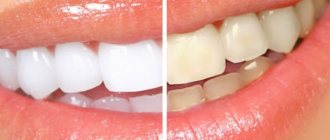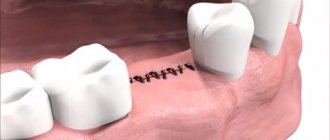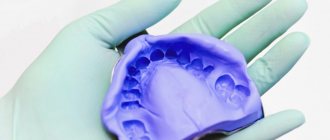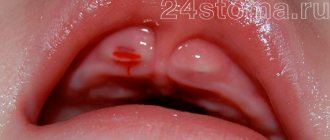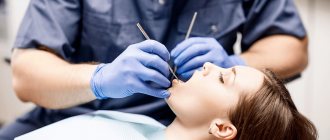Teeth cleaning with ultrasound is an innovative alternative to the classic procedure of mechanical removal of tartar.
Its advantage is minimal damage to tissues, thorough treatment of the oral cavity with better quality of teeth cleaning. Let's look at the new ultrasonic treatment technique in more detail, taking into account all its pros and cons, price and reviews.
Preparation for the procedure
First of all, the specialist examines the client and assesses whether the condition of his teeth and gums meets all the requirements and restrictions of this procedure.
The doctor must ask about any contraindications.
Attention! Since many of them are not detected during examination, pay close attention to the relevant section of the article.
Some clinics use a special safe solution, after applying which the tartar appears on the tooth enamel in a brighter shade. This method makes the specialist’s work easier.
Prevention
Preventing the appearance of dental plaque is quite simple and useful. It provides the following:
- Regular oral hygiene procedures in the morning and evening for three to five minutes;
- Preventive visits to the dentist every six months;
- The use of special toothpastes that remove plaque well;
- Using floss to remove food debris between teeth;
- Rinsing your mouth after every meal;
- Reducing the consumption of sweet and starchy foods, which create a favorable environment for the proliferation of pathogenic microorganisms;
- Eating fresh fruits and vegetables.
Main stages of ultrasonic processing
With the exception of certain details, ultrasonic removal of tartar occurs according to the following method.
Brushing teeth with a skyler
The first stage is a rough cleaning of the teeth, which is done using a professional instrument - a scaler (scaler, scaler).
Its operating principle is based on the oscillatory movements of ultrasonic waves (up to 20 thousand hertz):
- Skyler destroys tartar and other deposits.
- The dirt is immediately washed away by the pressure of water with a medicinal composition. The dentist tilts the tip of the device, directing the stream along the surface being treated so that it does not destroy the enamel.
- Then the moisture is pumped out with a saliva ejector.
This completes the first stage. Depending on the number of teeth cleaned, it takes about 40 minutes.
The process of removing stones with a skyler
Polishing
After rough processing, more precise correction occurs using the polishing method. The purpose of this stage is to remove residual dirt, smooth the enamel and whiten the teeth.
There are two polishing techniques:
- Mechanical - using brushes and paste to treat the space between the teeth, as well as strips - strips with a solution of sodium carbonate, which are glued to the surface and after a while removed along with the remnants of foreign elements separated from the enamel;
- Hardware - by supplying a stream of water with an abrasive gel, while the Air Flow device polishes teeth better, but is ineffective for heavy deposits on the enamel that it cannot remove.
Polishing your teeth takes approximately 15 minutes.
Teeth polishing using the Air flow method
Mechanical teeth polishing
Fluoridation
At the fluoridation stage, at the request of the customer, a strengthening gel is rubbed into the enamel. Due to fluoride, it promotes the rapid restoration of weakened tooth surfaces in places with worn enamel and prevents infection.
Important! Typically, all 3 stages of the procedure are completed in one visit to the dentist. Their total duration is adjusted depending on the degree of neglect of tartar, but usually does not exceed one hour.
Fluoride teeth strengthening procedure
Types of pathology
There are the following three main types of dental plaque:
- Soft plaque is a deposit on the surface of the enamel in the cervical area, has a light or yellow color. Mainly consists of food debris and microbes. Soft plaque is easily removed;
- Hard plaque is a deposit of yellow, brown, black color, which is localized mainly on the inner surface of the lower teeth. Mineralized food residues, salt deposits, microbes.
- Tartar is a hard plaque that has grown significantly in size over time. The formation is localized mainly in the cervical areas of the teeth, especially on the inner surface of the lower front teeth and upper lateral teeth. The stone can be located under and above the gum, filling interdental cracks and spaces. The formation puts pressure on the gums, causes inflammation of periodontal tissues, and a carious process.
Actions after the procedure
After ultrasound therapy, a patient with an incorrect bite must be given a pause, during which he does not put on braces.
If after the session it is planned to continue dental treatment, the patient is given several days of rest to restore areas with thinned enamel.
Then the doctor begins filling or installing dentures.
After ultrasound therapy, a patient with a malocclusion must be given a pause, during which he does not put on braces. This is also required to restore the enamel.
Also after therapy, slight bleeding of the gums is possible. In this case, the dentist takes action to stop it.
Service cost
Offers for dental correction with ultrasound are provided in private dental clinics. It is not included in the mandatory list of free procedures.
The average cost of one course varies between 1500-3000 rubles. The difference in price is due to the marketing policy of dentistry and additional actions, for example, the need for anesthesia.
In addition to complete cleaning, you can order cleaning of one or more teeth. In this case, you will have to pay from 100 to 150 rubles to clean each one.
Where to contact?
At the dental department of the CELT clinic, you can order professional plaque removal services using modern ultrasonic cleaning technology. Deep cleaning of gum pockets and teeth is carried out with a complex “Vector” device. We use effective anesthetics, which we select individually. Contact us! We will make your smile even more beautiful!
Make an appointment through the application or by calling +7 +7 We work every day:
- Monday—Friday: 8.00—20.00
- Saturday: 8.00–18.00
- Sunday is a day off
The nearest metro and MCC stations to the clinic:
- Highway of Enthusiasts or Perovo
- Partisan
- Enthusiast Highway
Driving directions
Advantages and disadvantages of ultrasound therapy
Thorough treatment of all root canals is the main advantage of ultrasonic teeth cleaning
The most important advantage of the service is the tangible cosmetic effect.
After the session, the patient is completely free of plaque in any part of the tooth surface. His teeth become brighter due to the whitening effect.
Unlike alternative methods of mechanical and chemical action, ultrasonic vibrations are not harmful to enamel and gums, and the procedure itself is quick and does not hurt.
Modern hardware ultrasound technologies have the following advantages:
- thorough treatment of all root canals;
- smoothing the relief surface of the enamel;
- correction of teeth shade in smokers;
- teeth whitening effect.
Unfortunately, the technique is not without a number of disadvantages:
- the presence of a large number of contraindications;
- the likelihood of mechanical injuries to dentin;
- high cost of treatment;
- Ultrasonic cleaning does not provide permanent results, so re-treatment may be required after one or two years.
The extent to which the benefits of ultrasound therapy outweigh its negative aspects depends on the professionalism of the dentist. Therefore, when making an appointment, pay attention to the reviews and qualifications of the doctor who will clean your teeth with ultrasound.
Prices for laser teeth cleaning
Of course, compared to other professional oral care methods, laser teeth cleaning is the most expensive option. The price is, on average, 15,000 rubles. It should be understood that it is justified by the need to improve the qualifications of doctors who have completed special preparatory courses, the use of expensive equipment and its maintenance. At a free consultation with our dentist, you can learn more specifically how laser teeth cleaning will affect your specific case.
How harmful can a service be?
A procedure approved by the medical community cannot be harmful by definition.
However, the method of ultrasonic cleaning of enamel requires a careful assessment of the condition of the teeth before starting treatment.
If the doctor misses the presence of contraindications or violates the order of work, the use of the device may harm the client’s health:
- cause damage to the enamel when it is weakened;
- injure the gums and cause bleeding.
More serious damage can be caused to the patient's body if he does not notify the dentist about existing contraindications.
Attention! Persons with pacemakers should be especially vigilant. Ultrasonic vibrations can damage the device that helps the heart function.
It is clear that the consequences of such treatment are not just harmful, but pose a mortal danger.
What are the benefits of a therapeutic and cosmetic session?
The correction procedure has a multifaceted beneficial effect:
- Under the influence of an ultrasonic wave, hard foreign deposits are broken down over the entire surface, including the space under the gums. This result is not available using similar methods.
- Along with the cleansing effect, the enamel whitens, which acquires a natural shade - softer and more natural than after other corresponding procedures.
- After cleaning with the device, the doctor will be able to quickly identify pathologies of the tissues of the interdental space and gums.
- The procedure is painless and much faster than other methods.
- Cleaning helps during periodontal treatment and fillings. It is often recommended to remove deposits before prosthetics.
These are only the main results that can be achieved after completing the course of treatment. The beneficial qualities of the procedure are not limited to this.
Contraindications
Innovative teeth cleaning is not suitable for everyone.
The list of contraindications includes:
- Ultrasonic teeth cleaning is not suitable for everyone; there are contraindications
installed pacemakers;
- arrhythmia of the heart muscle;
- dental implants, including crowns (the doctor avoids them during cleaning);
- asthma;
- the presence of diseases of the digestive system;
- increased sensitivity of teeth;
- age under 18 years;
- Chronical bronchitis;
- tuberculosis;
- acute respiratory infections and acute respiratory viral infections in the acute or chronic stage;
- HIV;
- oncology;
- frequent bleeding in the mouth;
- allergy to components used during ultrasonic cleaning;
- liver damage, in particular all forms of hepatitis;
- pregnancy and breastfeeding period.
In addition to the listed factors, there are individual characteristics of the body, after studying which the dentist may refuse to perform the procedure. In this case, you should choose an alternative option for whitening or removing tartar.
Air Flow for removing tartar
Air Flow is a technology used for professional teeth cleaning. It copes well with pigmented soft plaque, helps lighten tooth enamel to its natural shade, refreshes and disinfects the oral cavity. But with so many advantages, Air Flow is ineffective in the fight against tartar.
If a large amount of hard dental deposits have accumulated in the patient’s oral cavity, to remove them, properly clean with ultrasound or laser and only then use Air Flow.
The most common questions
Does the procedure require pain relief?
Of course, this is the question that primarily concerns patients at the dental clinic. Unlike outdated mechanical cleaning technology, ultrasound does not cause discomfort, so the average client will not need pain relief.
Anesthesia, in its mildest forms, may only be required when treating the subgingival area and if the patient has sensitive teeth.
Is it possible to remove tartar if you have untreated caries?
Ultrasound cleaning can be done for caries. The presence of a carious cavity in a tooth does not affect the operation of the device in any way. An infectious disease is not a contraindication for ultrasonic cleaning. On the contrary, during complex dental treatment, dentists often begin work by removing stones and only then begin to treat caries.
Is the device capable of removing stones under the gum?
Subgingival tartar is a dangerous defect, the damage of which sometimes leads to periodontitis. Fortunately, Skyler can remove it. The device will not only thoroughly clean the treated area, but also carry out ultrasonic polishing of the root surface.
Ultrasonic tartar cleaning - before and after the procedure
How is plaque formed and why is it important to remove it?
The formation of plaque occurs in three stages: in the first stage the deposits have a soft consistency, in the other two they have a hard consistency. The stages of education are as follows:
- Accumulation of minerals for two months, the beginning of the crystallization process;
- Continuation of the crystallization process for one and a half to two years;
- Saturation of crystals.
The price of dental plaque removal at the dentist is low, and anyone can afford it. But regular implementation of this procedure allows you to:
- minimize the risk of developing gum and dental diseases;
- eliminate halitosis (unpleasant odor);
- get rid of bleeding gums;
- significantly increase the effectiveness of the upcoming treatment;
- achieve natural color and shine of teeth.

